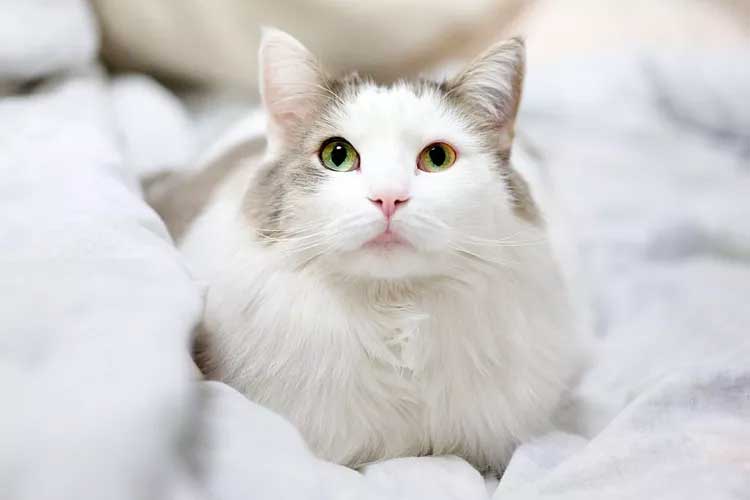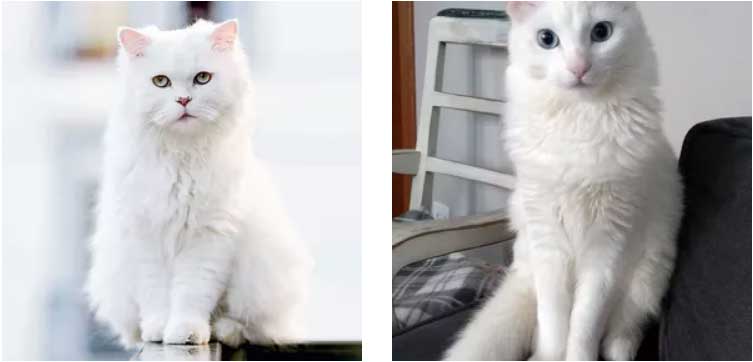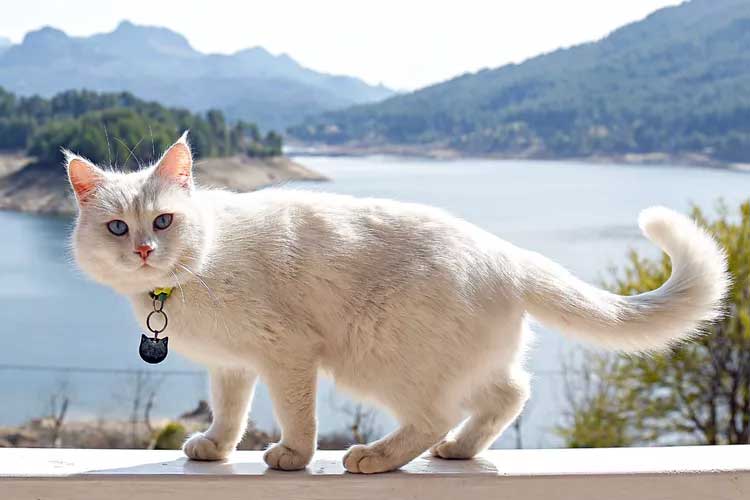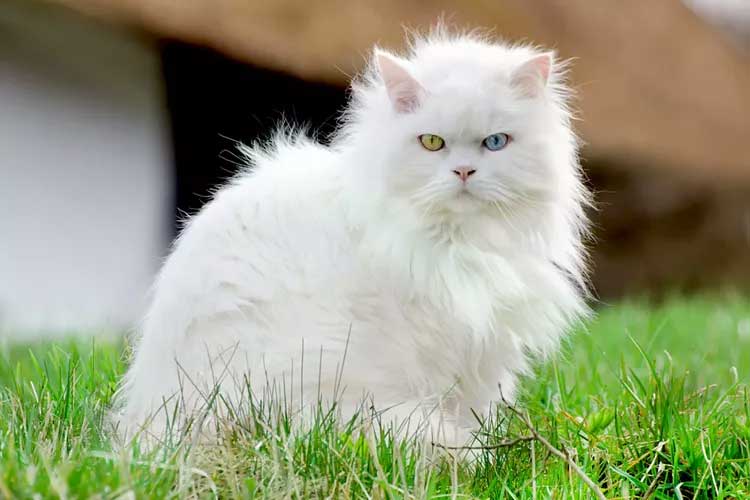With their high intelligence and gorgeous white fur, it’s easy to see why the Turkish Angora is a national treasure in their home country.

Turkish Angora Overview
| OFFICIAL NAME | Turkish Angora |
| COMMON NAME | Turkish Angora |
| PET HEIGHT | 9 to 14 inches |
| PET WEIGHT | 8 to 15 pounds |
| LIFESPAN | 9 to 14 years |
| GOOD WITH | cats, dogs, families, seniors |
| TEMPERAMENT | sociable |
| INTELLIGENCE | high |
| SHEDDING AMOUNT | normal |
| PLAYFULNESS | high |
| ENERGY LEVEL | active |
| VOCAL LEVEL | when necessary |
| COAT LENGTH | long |
| COLORS | black / ebony, blue / gray, lavender / silver, red / orange, white |
| OTHER TRAITS | easy to groom, easy to train, friendly toward humans, friendly toward other pets, friendly toward strangers, good for first-time pet owners, requires lots of grooming, strong loyalty tendencies |
Beloved in their native Turkey, the Turkish Angora is quite possibly the only domestic cat kept and raised in a zoo. For a time, these gorgeous, intelligent, regal cats were all thought to be deaf (more on that later) and were used so heavily in crossbreeding to build up the Persian breed, they were almost driven to extinction. While still a rare breed today, the Turkish Angora has a devoted following across the globe among people who want a soft, visually magnetic long-haired cat.
Appearance
The Turkish Angora is a medium-sized cat with a slender, delicate appearance, according to the breed standard. Angoras who originate from the Ankara Zoo in Turkey have a somewhat more substantial build, but all Angoras have a dignified, regal disposition and carry themselves with grace.
The Angora coat is long, very soft, and comes in a wide variety of colors and variations. White is traditionally the most popular—and the lone color produced at the Ankara Zoo—but Turkish Angoras can also be found in black, reds, browns, and grays, as well as tabby, tortoiseshell, and bicolor variations.
Their heads are small and round, with wide-set ears and large, almond-shaped eyes that come in amber, green, blue, or in a heterochromatic blue/amber or blue/green pairing.
Temperament
The Turkish Angora is highly intelligent. They are incredibly social cats who develop strong bonds with their family units, though they may often choose one person in particular to bond closest with, says Pam Nichols, DVM, president of the American Animal Hospital Association.
Turkish Angoras love spirited play, either with their human companions or on their own. A variety of toys will keep them entertained, and their independent streaks mean they can do well if left on their own for a few hours as well.
Deafness is a trait that runs in the Turkish Angora. This doesn't seem to affect their quality of life, however, and deaf Angoras live normal, healthy life spans, according to the Cat Fanciers' Association. They may, however, be louder than normal when vocalizing, since they can't hear their own voices and are unable to modulate.
Living Needs
Turkish Angoras can get along well with children if they're socialized to them well enough, though very little ones should be cautioned about pulling their long hair or tugging on tails. They're not as accepting of being handled by small kids as some other breeds, like the Himalayan, Nichols says.Angoras are happily accepting of other cats as well as dogs, if properly introduced. But they tend to do just as well on their own and don't traditionally exhibit a lot of stress behaviors if left alone.

Like all cats, Turkish Angoras need a variety of toys and a few scratching posts to keep themselves happy (and save your couch from claw marks). They also tend to be loft perchers, so give them some kind of high vantage point from which to sit and watch the house.
"They tend to be climbers [and] like to sit up high," Nichols says.
A tall cat tree, mounted cat shelves, or a high-up cat hammock will be your Angora's go-to spot. If not designated a tall place to sit, they're most likely going to commandeer one on top of a bookcase or door.
Care
Their long, silky coats have no undercoat, which makes grooming fairly easy for the Turkish Angora. But this doesn't mean you can skip grooming, because they need brushing one or two times a week in order to keep their coats shiny and looking good. Their hair is fine enough that it doesn't tend to clump or mat all that easily, but it will continue to grow until they are about 2 years old, so expect the brushing sessions to get more involved as your kitten grows. Turkish Angoras also shed a lot, Nichols says, so routine brushing will keep their loose fur from ending up on your furniture.Keeping an eye on their ears and around their eyes will be important as well, as the longer fur can trap dirt around those areas that could potentially lead to infection. A damp cloth around the eyes and ears should be enough to remove any buildup.

And, like all cats, you'll need to trim your Angora's nails frequently, feed him the right amount of healthy food, and keep his litter box clean.
Health
For a long period in the 19th century and earlier, it was presumed all Turkish Angoras were deaf. While that's certainly not the case, it is a bigger issue in the breed than in most. There seems to be a connection between the gene for white fur and blue eyes and the breed's hearing. As such, white cats with blue eyes have a higher than average chance of being deaf. This potential extends to the odd-eyed cats, too, with the side having the blue eye being deaf.Hereditary ataxia is a rare but serious condition in some Turkish Angora kittens. The kittens affected by ataxia have shaking movements and do not survive to adulthood.

Another genetic illness that is rare but known to the breed is hypertrophic cardiomyopathy, which is a cardiac condition usually found between the ages of 2–6, with male cats being affected more commonly.
"Hypertrophic cardiomyopathy can be manageable, but at some point, a cat that has it is probably going to go into heart failure," says Michelle Beck, DVM, CCRT, CVA, of the Backlund Animal Clinic in Omaha, Neb. "When it comes to congestive heart failure, usually about a year after detection is the lifespan."
Nichols also says the Turkish Angora can be susceptible to chronic kidney disease (CKD), which is the chronic loss of kidney function over time. There is no cure, according to the Cornell Feline Health Center, but treatment is available.
History
The wild ancestors of the Turkish Angora were some of the first cats domesticated in the Middle East's Fertile Crescent. An old breed, Europeans noticed them sometime around the 16th century, according to the Turkish Angora Breed Council (TABC), when their brilliant white, long-hair coats made them prized as breeding stock for the more popular Persian.
So prolific was this outbreeding process that it nearly drove the Angora to extinction by the end of the 19th century, as their own bloodlines were given a back seat to building up the Persian's. The Turkish Angora was saved from oblivion by caretakers in their home country who began collecting white Angoras for breeding and preservation in the Ankara Zoo in the early 20th century, according to the TABC. The zoo has bred and raised Angoras ever since, but didn't begin selling cats for export outside of Turkey until the 1960s when breeding pairs began making their way to Canada and the United States.
Today, Turkish Angoras are still a rare breed, but they were accepted by the Cat Fanciers' Association for championship in 1973. All registered Angoras must still be able to trace their lineage back to the Ankara Zoo.
Fun Facts
* While Turkish Angoras share a lineage with the Turkish van, they are genetically distinct breeds.* You can still go to the Ankara Zoo in Turkey and see the Angora.